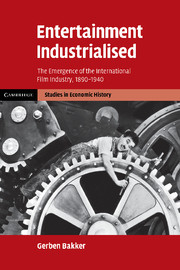Book contents
- Frontmatter
- Contents
- List of figures
- List of tables
- Acknowledgements
- Prologue
- 1 Introduction
- Part I The rise of entertainment
- Part II The rise of the international film industry
- Part III Entertainment Industrialised
- 9 International market integration: firms versus trade
- 10 Industrialising the discovery process
- 11 At the origins of increased productivity growth in services
- 12 Epilogue: after television
- Bibliography
- Index
10 - Industrialising the discovery process
Published online by Cambridge University Press: 08 July 2009
- Frontmatter
- Contents
- List of figures
- List of tables
- Acknowledgements
- Prologue
- 1 Introduction
- Part I The rise of entertainment
- Part II The rise of the international film industry
- Part III Entertainment Industrialised
- 9 International market integration: firms versus trade
- 10 Industrialising the discovery process
- 11 At the origins of increased productivity growth in services
- 12 Epilogue: after television
- Bibliography
- Index
Summary
Tastes and fashions, notably in popular entertainment, can be ‘created’ only within very narrow limits; they have to be discovered before being exploited and shaped.
Eric HobsbawmCulver City, August 1944. Producer David O. Selznick is supervising the final changes to The House of Dr. Edwards, the latest film by Alfred Hitchcock. Selznick has sunk nearly $1.7 million in the film and is determined to get it back. Feeling uncomfortable about the title, he contacts Audience Research, a market research firm, to test several titles among cinema-goers. While Hidden Impulse and The Couch register little interest, Edwards – Hitchcock's favourite – and, finally, Spellbound, ring a bell. Selznick notices that while men prefer Edwards to Spellbound by a 15 per cent margin, women prefer Spellbound to Edwards by 13 per cent. Since women ‘bring men to the theatre much more than men bring women’, and Hitchcock's name already guarantees a masculine appeal, Selznick ignores Hitchcock and decides the ultimate title will be Spellbound.
By the 1940s, adequate knowledge about consumer preferences had become essential for survival in the motion picture industry. Film companies had been among the first customers of market research firms using scientific research design and random sampling, which emerged in the 1930s. Many films considered classics today were shaped by feedback from market research. Ever since the emergence of cinemas in the mid-1900s, the film industry had been obtaining detailed knowledge about the tastes, desires and habits of consumers.
- Type
- Chapter
- Information
- Entertainment IndustrialisedThe Emergence of the International Film Industry, 1890–1940, pp. 341 - 370Publisher: Cambridge University PressPrint publication year: 2008
- 1
- Cited by

